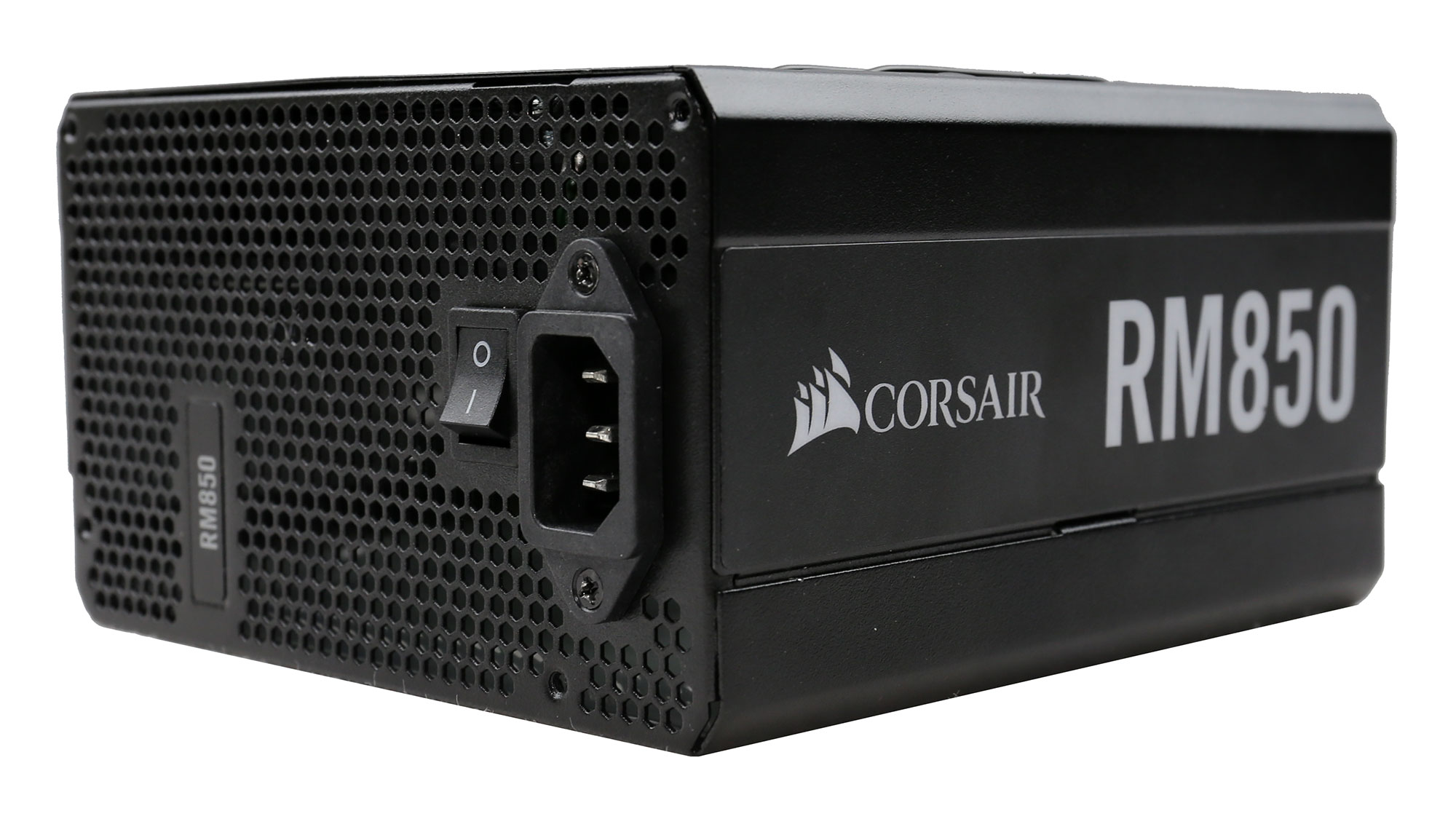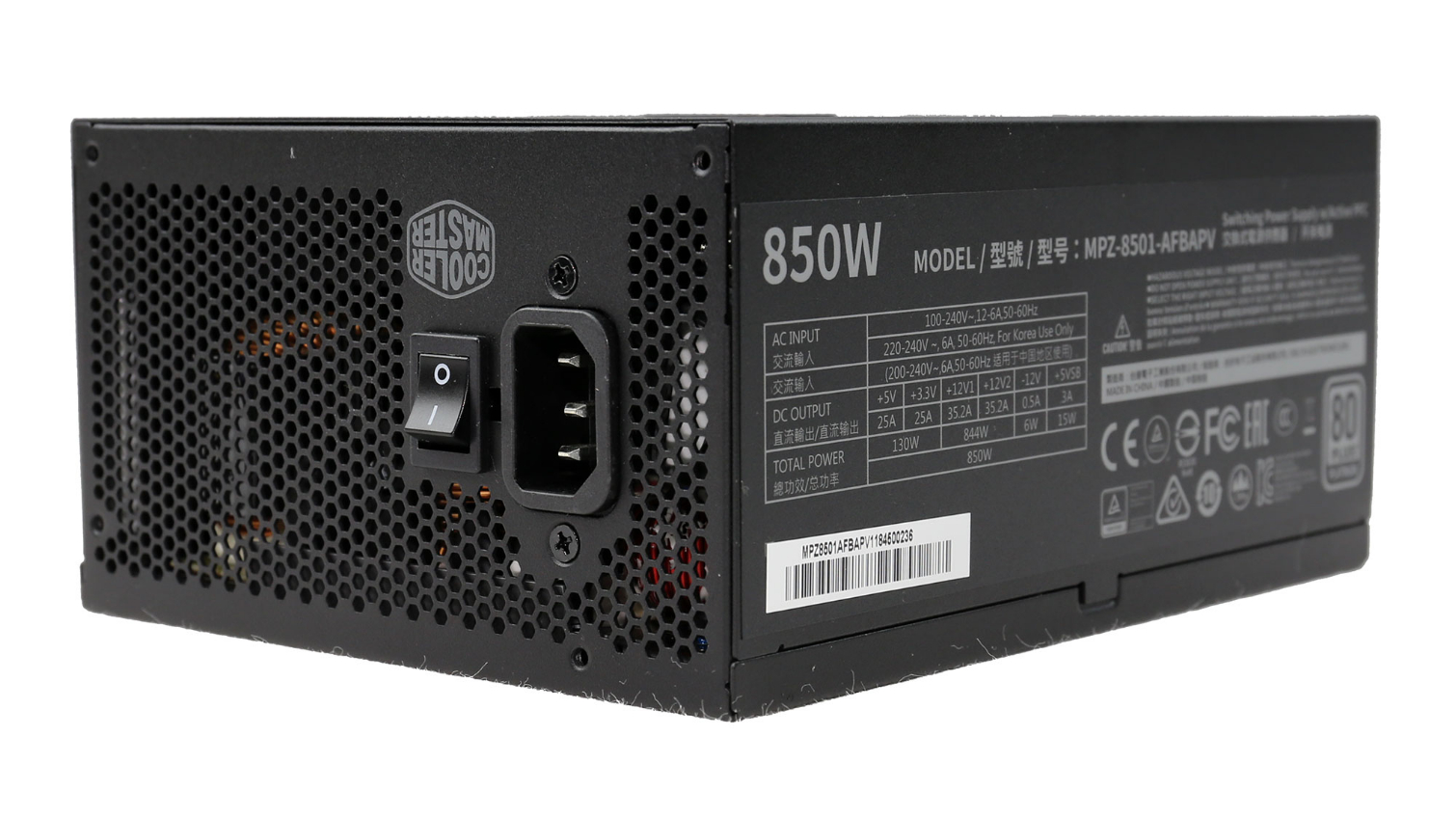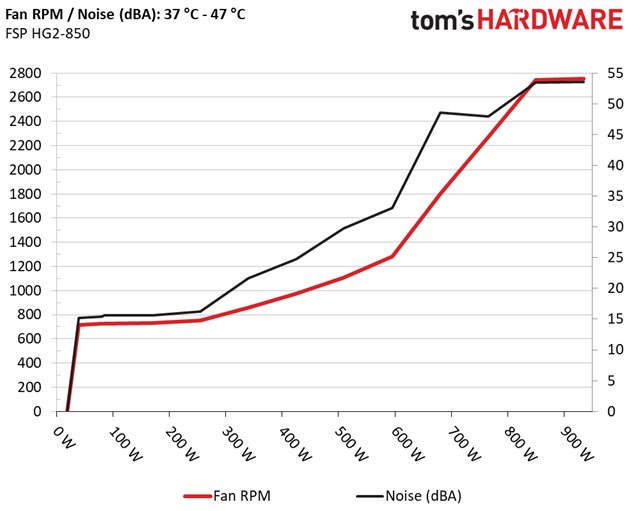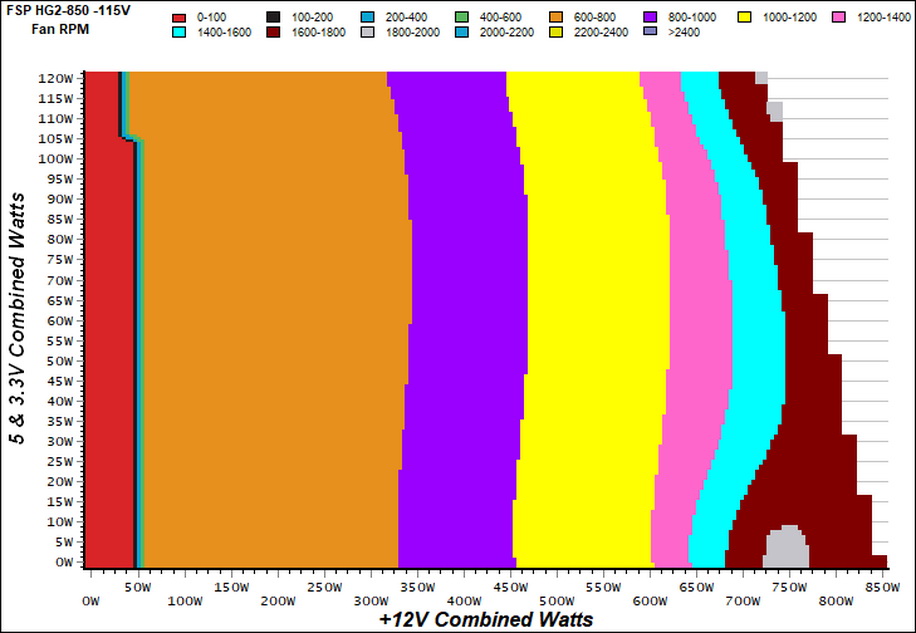FSP Hydro G PRO 850W Power Supply Review: Great Build, So-So Performance
Why you can trust Tom's Hardware
Load Regulation, Hold-Up Time, Inrush Current, Efficiency and Noise
To learn more about our PSU tests and methodology, please check out How We Test Power Supply Units.
Primary Rails and 5VSB Load Regulation
The following charts show the main rails' voltage values recorded between a range of 40W up to the PSU's maximum specified load, along with the deviation (in percent). Tight regulation is an important consideration every time we review a power supply because it facilitates constant voltage levels despite varying loads. Tight load regulation, among other factors, also improves the system’s stability, especially under overclocked conditions. And at the same time, it applies less stress to the DC-DC converters that many system components utilize.
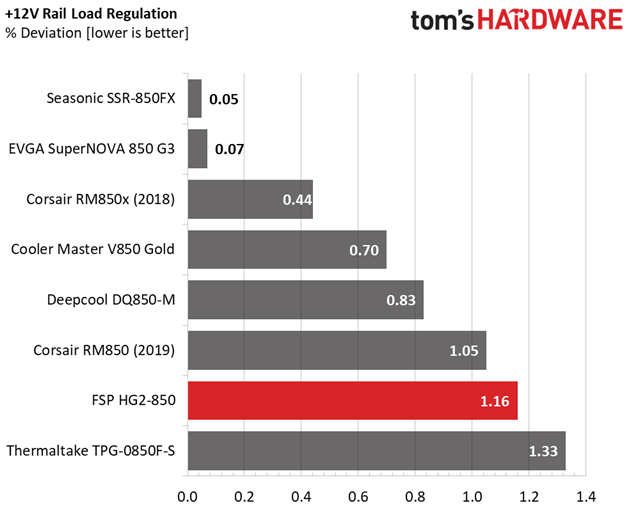
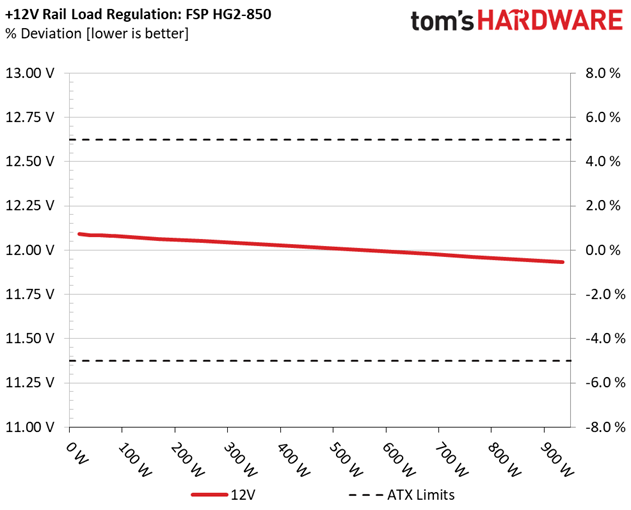
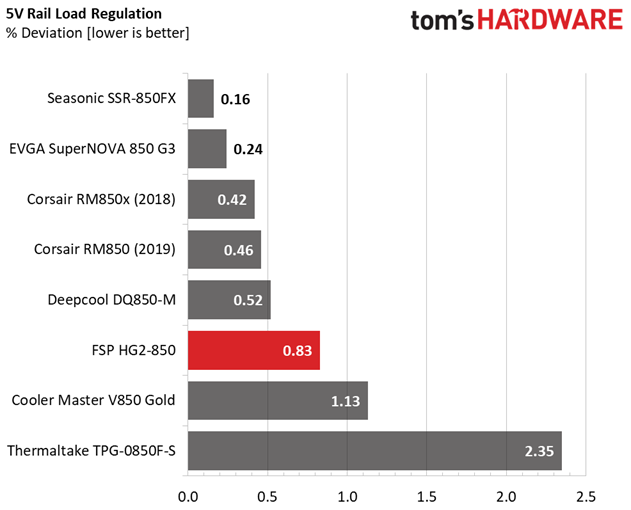


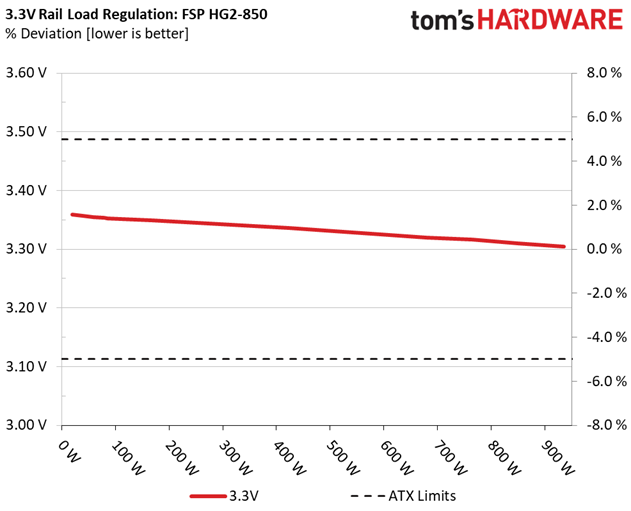

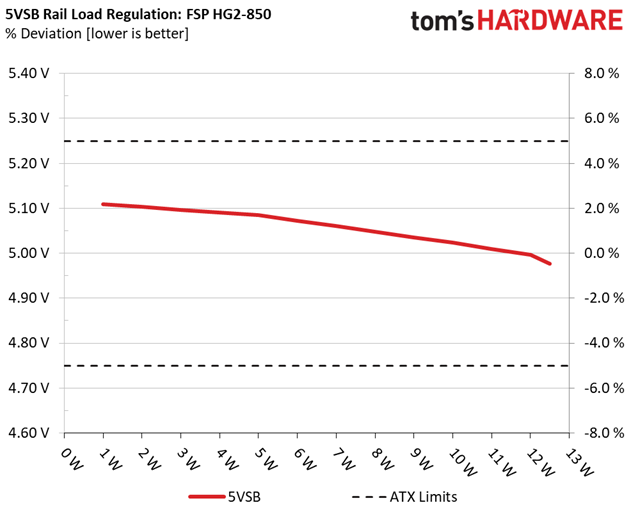
The load regulation at +12V is not as tight as we would like it to be. On the minor rails, the performance is not top-notch. But it's still satisfactory, given that those rails are not heavily utilized by today's systems.
Hold-Up Time
Put simply; hold-up time is the amount of time that the system can continue to run without shutting down or rebooting during a power interruption.

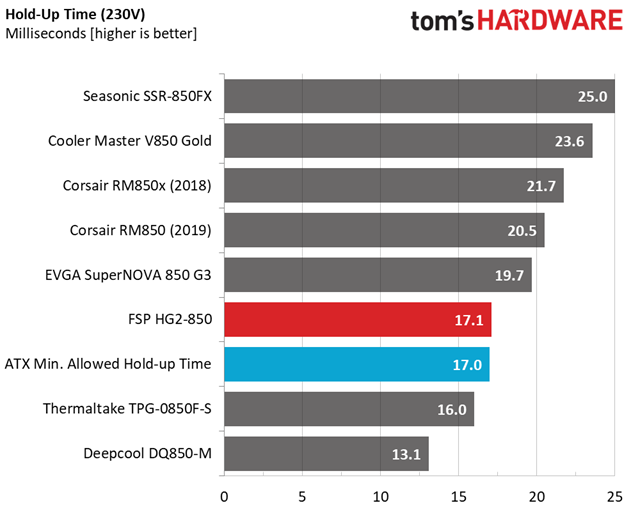
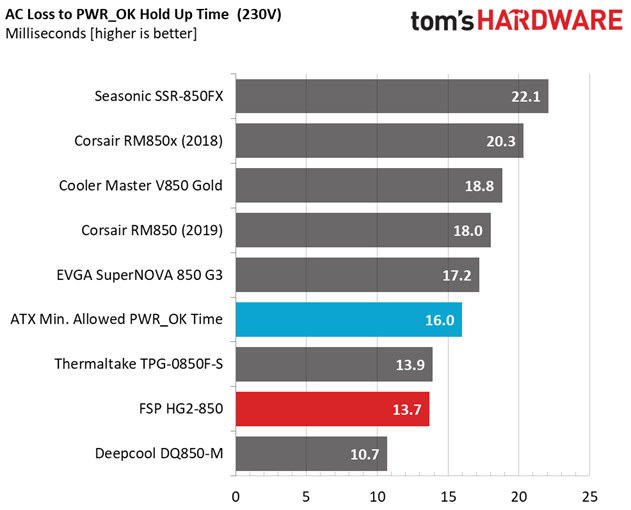
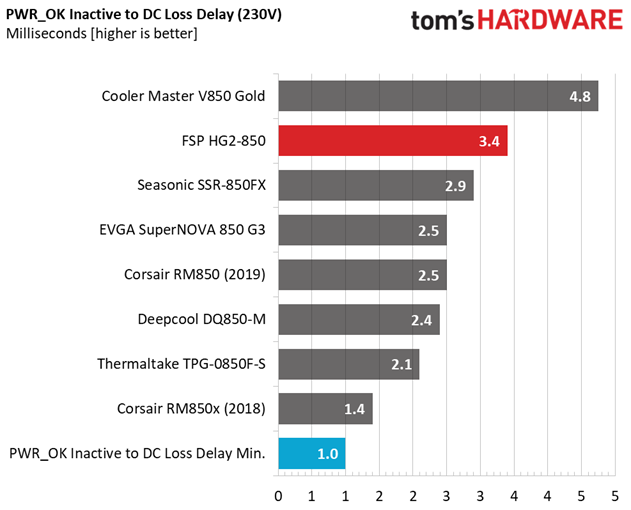
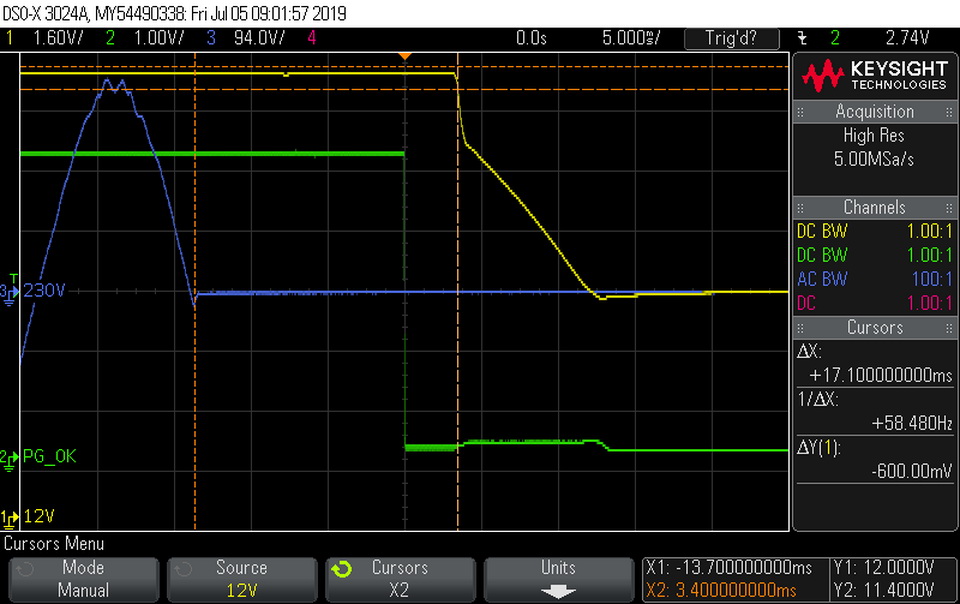
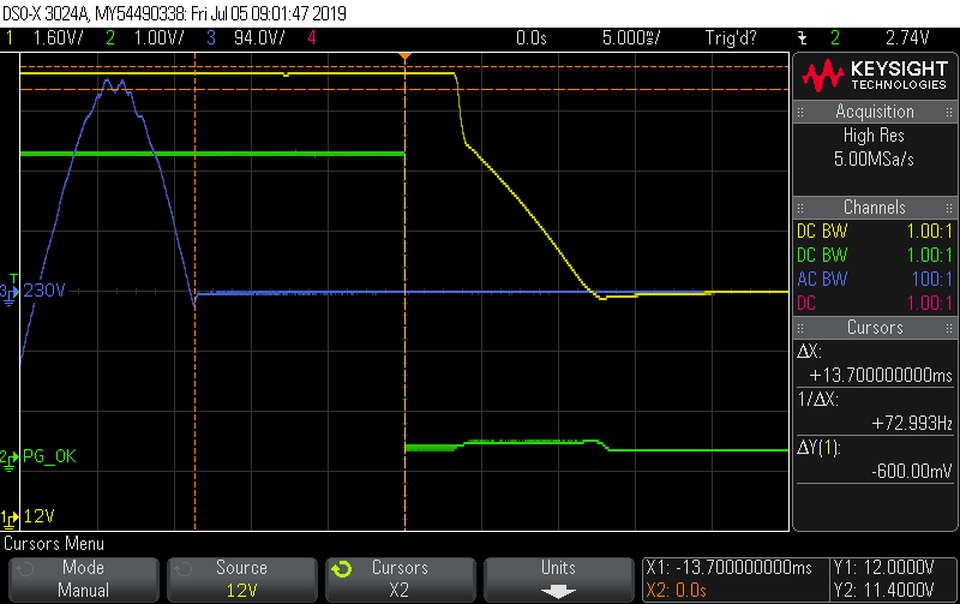
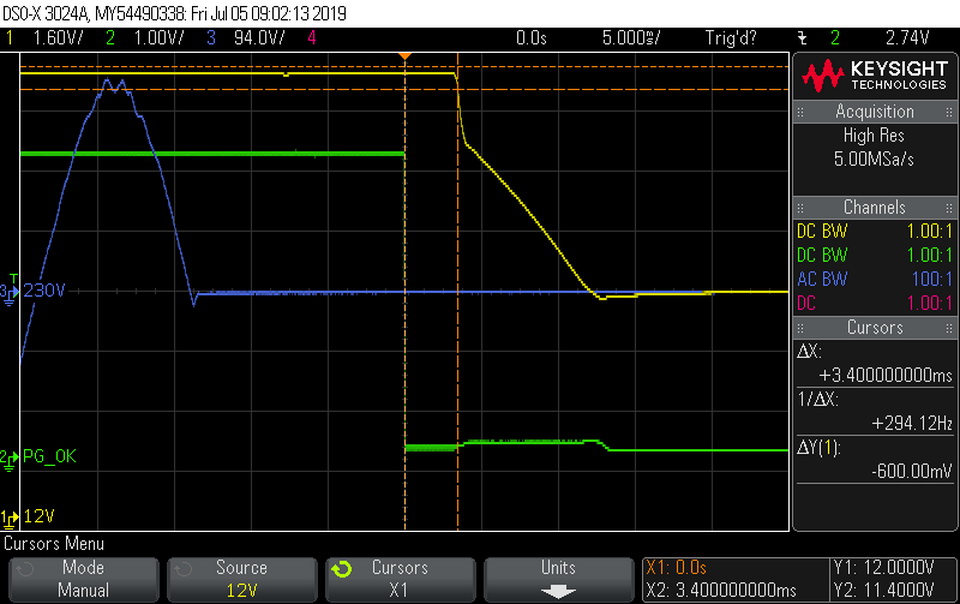
The hold-up time barely exceeds the 17ms limit that the ATX spec sets, but this is not the case for the power OK signal's hold-up time, which is lower than 16ms.
Inrush Current
Inrush current, or switch-on surge, refers to the maximum, instantaneous input current drawn by an electrical device when it is first turned on. A large enough inrush current can cause circuit breakers and fuses to trip. It can also damage switches, relays, and bridge rectifiers. As a result, the lower the inrush current of a PSU right as it is turned on, the better.
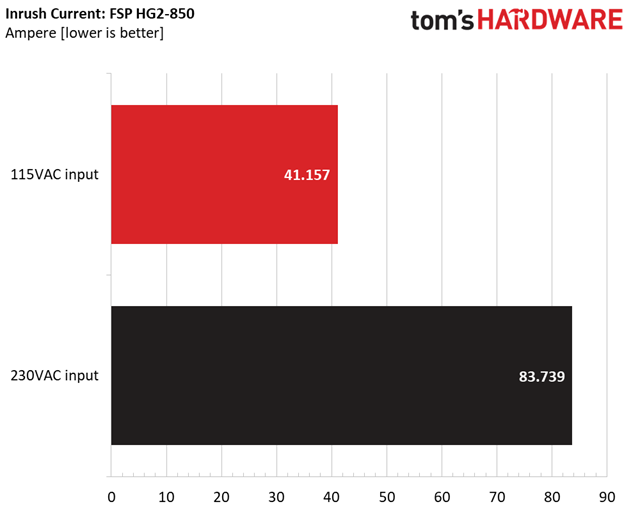

The inrush current is a bit higher than the average.
Get Tom's Hardware's best news and in-depth reviews, straight to your inbox.
10-110% Load Tests
These tests reveal the PSU’s load regulation and efficiency levels under high ambient temperatures. They also show how the fan speed profile behaves under increased operating temperatures.
| Test # | 12V | 5V | 3.3V | 5VSB | DC/AC (Watts) | Efficiency | Fan Speed (RPM) | PSU Noise (dB[A]) | Temps (In/Out) | PF/AC Volts |
|---|---|---|---|---|---|---|---|---|---|---|
| 1 | 5.243A | 1.976A | 1.969A | 0.983A | 84.935 | 85.698% | 729 | 15.6 | 40.16°C | 0.978 |
| 12.079V | 5.063V | 3.353V | 5.085V | 99.110 | 42.86°C | 115.11V | ||||
| 2 | 11.482A | 2.967A | 2.956A | 1.183A | 169.430 | 89.753% | 734 | 15.6 | 40.40°C | 0.994 |
| 12.064V | 5.059V | 3.349V | 5.072V | 188.774 | 43.59°C | 115.11V | ||||
| 3 | 18.133A | 3.463A | 3.437A | 1.383A | 254.523 | 90.747% | 752 | 16.2 | 41.40°C | 0.994 |
| 12.051V | 5.055V | 3.345V | 5.061V | 280.474 | 45.15°C | 115.11V | ||||
| 4 | 24.798A | 3.961A | 3.949A | 1.585A | 339.720 | 90.982% | 861 | 21.6 | 41.90°C | 0.995 |
| 12.038V | 5.051V | 3.341V | 5.048V | 373.393 | 46.23°C | 115.11V | ||||
| 5 | 31.146A | 4.958A | 4.948A | 1.788A | 425.026 | 90.618% | 975 | 24.8 | 42.14°C | 0.995 |
| 12.024V | 5.046V | 3.336V | 5.035V | 469.032 | 47.44°C | 115.10V | ||||
| 6 | 37.450A | 5.952A | 5.944A | 1.992A | 509.553 | 90.041% | 1106 | 29.8 | 42.80°C | 0.995 |
| 12.009V | 5.042V | 3.331V | 5.023V | 565.912 | 48.91°C | 115.10V | ||||
| 7 | 43.835A | 6.952A | 6.947A | 2.197A | 594.877 | 89.335% | 1283 | 33.1 | 43.02°C | 0.995 |
| 11.994V | 5.037V | 3.325V | 5.009V | 665.897 | 49.38°C | 115.10V | ||||
| 8 | 50.241A | 7.952A | 7.952A | 2.403A | 680.208 | 88.428% | 1801 | 48.6 | 43.74°C | 0.994 |
| 11.978V | 5.032V | 3.320V | 4.996V | 769.221 | 50.76°C | 115.10V | ||||
| 9 | 57.059A | 8.456A | 8.446A | 2.407A | 765.124 | 87.592% | 2273 | 48.0 | 44.76°C | 0.993 |
| 11.963V | 5.028V | 3.316V | 4.987V | 873.509 | 52.02°C | 115.09V | ||||
| 10 | 63.835A | 8.961A | 8.973A | 2.512A | 849.797 | 86.574% | 2745 | 53.5 | 45.52°C | 0.992 |
| 11.946V | 5.024V | 3.310V | 4.977V | 981.587 | 53.55°C | 115.10V | ||||
| 11 | 71.021A | 8.966A | 8.985A | 2.516A | 934.567 | 85.498% | 2752 | 53.6 | 46.94°C | 0.991 |
| 11.931V | 5.021V | 3.305V | 4.969V | 1093.091 | 55.60°C | 115.09V | ||||
| CL1 | 0.143A | 14.005A | 13.998A | 0.000A | 118.868 | 83.465% | 1075 | 28.0 | 42.30°C | 0.989 |
| 12.066V | 5.040V | 3.326V | 5.088V | 142.417 | 47.82°C | 115.11V | ||||
| CL2 | 70.842A | 1.001A | 1.000A | 1.000A | 860.380 | 87.028% | 2613 | 51.8 | 45.27°C | 0.992 |
| 11.956V | 5.040V | 3.327V | 5.021V | 988.620 | 53.80°C | 115.09V |
The PSU doesn't have a problem delivering more than its full power at close to 47 degrees Celsius. The problem is the small fan, which has to spin at very high speeds to cope with the thermal load, hence the noise is way too high. Another thing worth mentioning here is that the PF slightly decreases at higher loads, while usually is the other way around.
20-80W Load Tests
In the following tests, we measure the PSU's efficiency at loads significantly lower than 10% of its maximum capacity (the lowest load the 80 PLUS standard measures). This is important for representing when a PC is idle with power-saving features turned on.
| Test # | 12V | 5V | 3.3V | 5VSB | DC/AC (Watts) | Efficiency | Fan Speed (RPM) | PSU Noise (dB[A]) | PF/AC Volts |
|---|---|---|---|---|---|---|---|---|---|
| 1 | 1.196A | 0.494A | 0.476A | 0.196A | 19.563 | 67.255% | 0 | <6.0 | 0.873 |
| 12.090V | 5.068V | 3.359V | 5.109V | 29.088 | 115.12V | ||||
| 2 | 2.458A | 0.988A | 0.981A | 0.392A | 40.006 | 78.336% | 718 | 15.2 | 0.943 |
| 12.086V | 5.066V | 3.357V | 5.103V | 51.070 | 115.11V | ||||
| 3 | 3.649A | 1.482A | 1.461A | 0.589A | 59.500 | 82.928% | 722 | 15.3 | 0.966 |
| 12.083V | 5.064V | 3.355V | 5.096V | 71.749 | 115.12V | ||||
| 4 | 4.910A | 1.976A | 1.966A | 0.786A | 79.907 | 85.409% | 726 | 15.4 | 0.978 |
| 12.079V | 5.063V | 3.354V | 5.090V | 93.558 | 115.12V |
Only during the first test is the PSU's fan not activated. FSP's engineers didn't leave much room for the passive operation.
Efficiency
Next, we plotted a chart showing the PSU’s efficiency at low loads, and loads from 10 to 110% of its maximum-rated capacity. The higher a PSU’s efficiency, the less energy goes wasted, leading to a reduced carbon footprint and lower electricity bills.
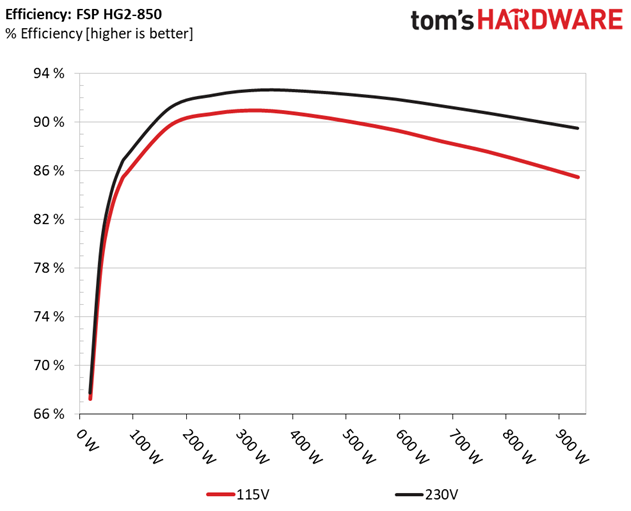
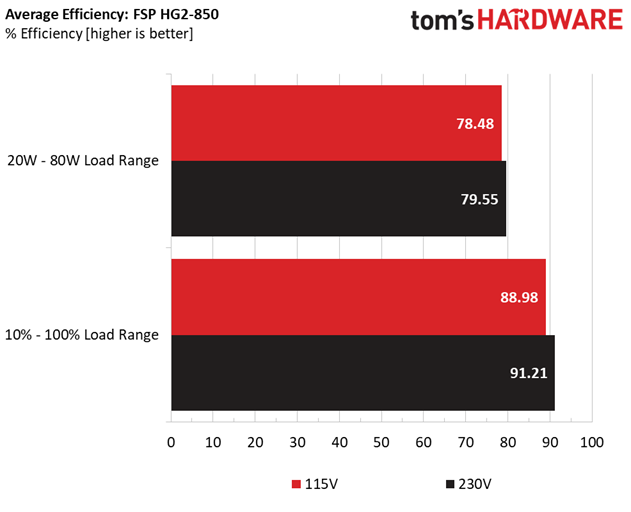
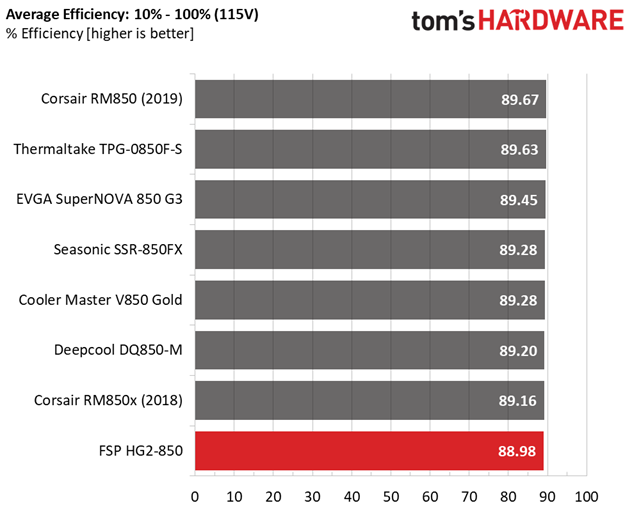
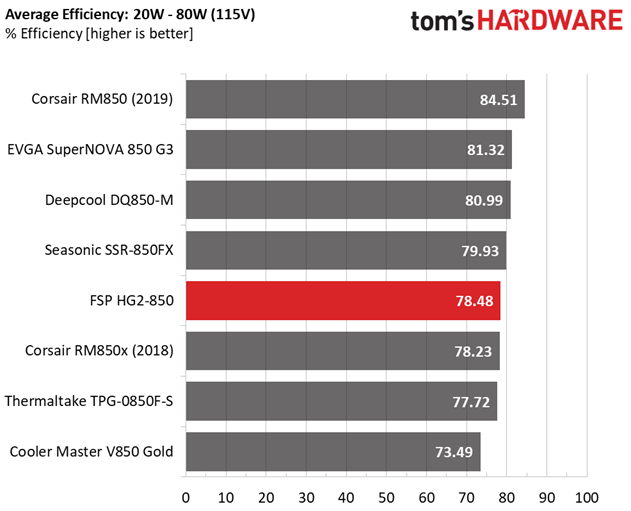
The efficiency levels under both light and normal loads are not so high.
5VSB Efficiency
| Test # | 5VSB | DC/AC (Watts) | Efficiency | PF/AC Volts |
|---|---|---|---|---|
| 1 | 0.100A | 0.512 | 73.039% | 0.066 |
| 5.114V | 0.701 | 115.12V | ||
| 2 | 0.250A | 1.278 | 78.598% | 0.142 |
| 5.111V | 1.626 | 115.12V | ||
| 3 | 0.550A | 2.808 | 80.343% | 0.253 |
| 5.104V | 3.495 | 115.12V | ||
| 4 | 1.000A | 5.096 | 80.761% | 0.346 |
| 5.095V | 6.310 | 115.12V | ||
| 5 | 1.500A | 7.627 | 79.981% | 0.403 |
| 5.084V | 9.536 | 115.12V | ||
| 6 | 2.501A | 12.656 | 79.263% | 0.458 |
| 5.061V | 15.967 | 115.12V |
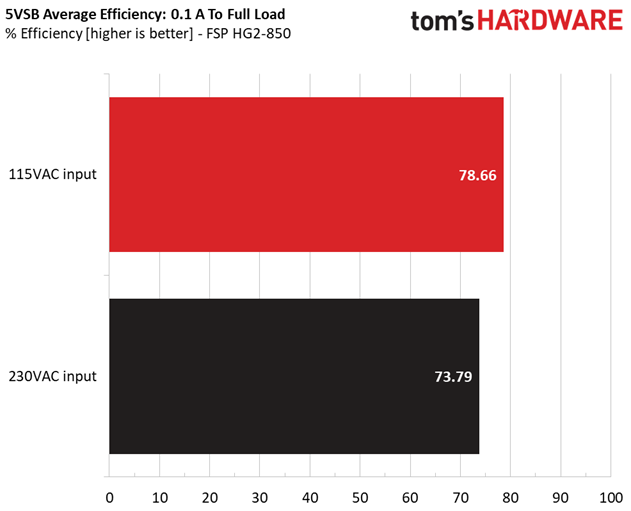

The 5VSB rail is highly efficient. It makes us wonder why they didn't use the same at the Dagger Pro 650W unit, which suffers in this area.
Power Consumption In Idle And Standby
| Mode | 12V | 5V | 3.3V | 5VSB | Watts | PF/AC Volts |
|---|---|---|---|---|---|---|
| Idle | 12.086V | 5.067V | 3.358V | 5.116V | 7.990 | 0.484 |
| 115.1V | ||||||
| Standby | 0.075 | 0.007 | ||||
| 115.1V |
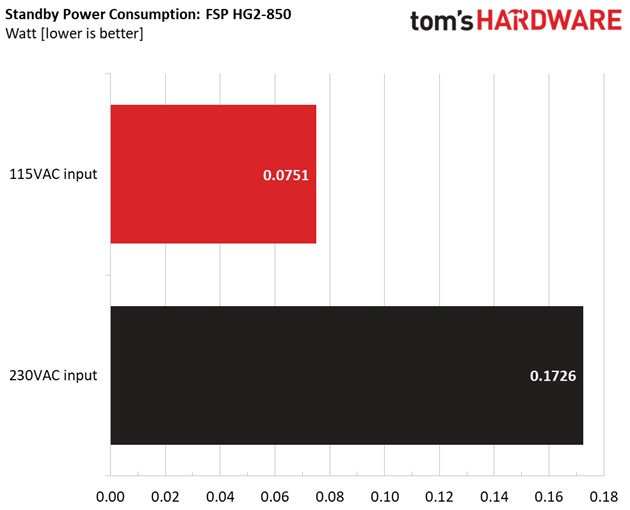

Fan RPM, Delta Temperature, And Output Noise
All results are obtained between an ambient temperature of 37 to 47 degrees Celsius (98.6 to 116.6 degrees Fahrenheit).
The semi-passive operation doesn't last long. Under high ambient temperatures and higher loads, the fan profile is aggressive.
The following results were obtained at 30 to 32 degrees Celsius (86 to 89.6 degrees Fahrenheit) ambient temperature.
Even with normal ambient temperatures, the passive operation lasts for only up to 50W loads. The PSU's fan starts to get loud with higher than 640W loads.
MORE: Best Power Supplies
MORE: How We Test Power Supplies
MORE: All Power Supply Content
Current page: Load Regulation, Hold-Up Time, Inrush Current, Efficiency and Noise
Prev Page Specifications and Part Analysis Next Page Protection Features, DC Power Sequencing, Cross-Load Tests and Infrared Images
Aris Mpitziopoulos is a contributing editor at Tom's Hardware, covering PSUs.
